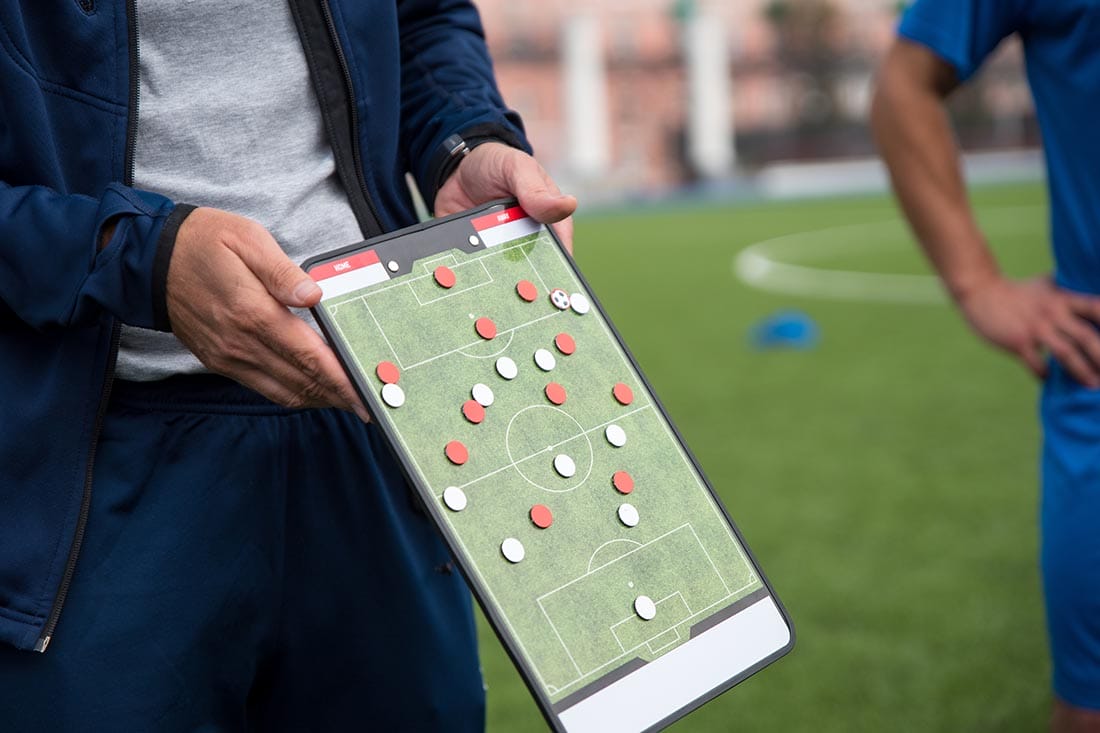The Evolution of the Modern Soccer Coach: Experience, Tactics, and Soccer Science
Written By: Nikos Koundarakis (High-Performance Expert)
The world’s most popular sport, soccer has witnessed a significant transformation in recent decades especially across the soccer coaching trends, and as a result of it, the role of the soccer coach has also evolved. Gone are the days when a coach’s responsibilities were solely focused on team selection and training sessions. Modern soccer coaching techniques
are now an amalgamation of experience, tactical acumen, and the utilization of soccer science. This article will explore the evolution of coaching in soccer, highlighting the advancements in soccer coaching, changing player dynamics, tactical innovation, and the impact of soccer science.
In the ever-evolving landscape of soccer, the dynamics of players have changed, and coaches have had to adapt to these shifts. Over the past two decades, the profile of professional soccer players has undergone notable transformations, necessitating coaches to adjust their approach (Mackenzie & Cushion, 2013; Praca et al., 2021).
One significant aspect of this transformation is the rise of Generation Z players, who have grown up in the digital age. Modern coaches must adapt their coaching techniques to cater to a generation raised on technology.
Communication with players has expanded to various digital platforms, and training sessions are often tailored to suit the tech-savvy preferences of younger players. Moreover, coaches must understand the impact of social media on player motivation and mental well-being, ensuring that it is harnessed as a positive tool for development rather than a distraction.
Additionally, the globalization of soccer has resulted in an influx of players from diverse cultural backgrounds. Coaches must now possess cultural sensitivity, fostering inclusivity and cohesion within multicultural teams.
Understanding players’ different communication styles, dietary needs, and religious practices has become integral to the role of a successful coach, creating an environment that embraces diversity and maximizes each player’s potential.
Tactical Innovation in Elite Soccer
Tactical innovation has significantly transformed the dynamics of soccer at the elite level, revolutionizing the way the game is played and altering strategic approaches. These innovations have been driven by the desire to gain a competitive edge and maximize team performance. While I will avoid using specific copyrighted terms, I will provide an overview of some key tactical changes that have had a profound impact on the sport.
One notable tactical innovation is the increased emphasis on pressing and high-intensity defensive systems. Teams have adopted a more proactive approach to defending, seeking to regain possession quickly and disrupt the opponent’s build-up play.
This requires coordinated pressing from multiple players, often in specific zones of the field, to force turnovers and create counter-attacking opportunities. Such tactical adjustments have raised the overall intensity of the game and put a premium on physical fitness and teamwork.
Another significant tactical development is the widespread use of positional interchangeability. Rather than adhering strictly to fixed positions, players are encouraged to interchange their positions during matches.
This fluidity allows teams to create numerical advantages in specific areas, confuse opponents, and exploit spaces more effectively. Players with versatile skill sets are highly valued, as they can seamlessly switch positions and contribute to various phases of play.
Moreover, the introduction of advanced data analytics and technology has played a crucial role in tactical innovation.
Coaches and analysts now have access to vast amounts of data, such as player tracking, passing statistics, and spatial analysis. These insights help teams identify patterns, weaknesses, and opportunities for improvement. Tactical adjustments are then made based on this information, leading to more effective game plans and strategies. Additionally, set-piece strategies have become more sophisticated.
Teams now meticulously analyze opponents’ defensive setups to identify vulnerabilities and exploit them during corner kicks, free kicks, and throw-ins. This involves intricate positioning, decoy runs, and coordinated movements to create scoring opportunities from dead-ball situations. Set pieces have increasingly become a crucial aspect of the game, capable of turning the tide of a match.
Furthermore, the concept of playing out from the back has gained prominence. Instead of resorting to long, direct passes, teams prioritize short, controlled build-up play from their own defensive third. This approach requires defenders to possess good technical skills and composure under pressure, as they aim to bypass the opponent’s pressing and initiate attacks from deeper positions.
By doing so, teams can maintain possession, dictate the tempo of the game, and create openings in the opponent’s defensive structure.
Overall, tactical innovation has profoundly impacted elite-level soccer, transforming the game’s dynamics in various ways. From pressing and defensive systems to positional interchangeability, set-piece strategies, and data-driven decision-making, teams have embraced new approaches to gain an edge over their opponents. These innovations continue to evolve, driven by the constant pursuit of success and the desire to adapt to the ever-changing nature of the sport. (Memmert et al., 2017; Goes et al., 2021).
Integrating Data Analysis to Enhance Soccer Performance
Integrating data analysis has had a profound impact on the dynamics of soccer at the elite level, revolutionizing the way teams prepare, strategize, and evaluate performance.
By leveraging advanced analytics, teams have gained valuable insights into various aspects of the game, enabling them to make more informed decisions and optimize their performance on the field.
One significant change brought about by data analysis is the ability to assess player performance objectively and accurately. Metrics such as distance covered, sprints made, pass completion rates, and successful tackles provide detailed information about a player’s contributions during a match.
Coaches and analysts can use this data to identify areas for improvement, evaluate player effectiveness in specific roles, and make informed decisions regarding team selection and substitutions. Objective analysis helps remove subjective biases, ensuring that decisions are based on empirical evidence rather than personal opinions.
Data analysis has also influenced tactical approaches in soccer. By studying patterns and trends, teams can identify opponent weaknesses, understand their playing style, and develop game plans that exploit these insights.
Detailed positional data allows teams to assess spatial relationships, identify gaps in the opponent’s defense, and create attacking strategies that maximize scoring opportunities. Moreover, teams can study their own performance to refine their tactical approach, adjust formations, and improve overall team cohesion.
Set-piece strategies have been significantly influenced by data analysis as well. By analyzing opponents’ defensive setups during corners, free kicks, and throw-ins, teams can identify patterns and vulnerabilities. This information helps coaches and players devise intricate set-piece routines that increase the likelihood of scoring.
Data-driven insights allow teams to develop innovative routines, incorporating decoy runs, coordinated movements, and precise timing to create goal-scoring opportunities.
Player recruitment and scouting have also been transformed by data analysis. With access to comprehensive player databases and performance metrics, teams can identify potential transfer targets and evaluate their suitability for specific roles within the team.
Data analysis provides a comprehensive view of a player’s strengths, weaknesses, and compatibility with the team’s style of play. This information aids in making informed transfer decisions, optimizing squad composition, and building cohesive teams.
Moreover, data analysis has enhanced injury prevention and player fitness management. By monitoring player workload, tracking injury rates, and analyzing physiological data, teams can make data-driven decisions to manage player fitness and reduce the risk of injuries.
This enables coaches to optimize training programs, implement recovery strategies, and make informed decisions regarding player rotation and workload management. It should be noted that data analysis has enhanced the spectator experience and fan engagement.
Real-time analytics and visualizations provide fans with deeper insights into the game, allowing them to understand key performance indicators and appreciate the intricacies of tactical decisions. Data-driven graphics, such as heat maps and passing networks, enhance the viewing experience, providing a new level of analysis and discussion for fans and pundits alike.
Furthermore, modern coaches prioritize flexibility and adaptability in their tactical approach. They understand that no single tactic or formation is universally effective.
Instead, coaches tailor their game plans to suit specific opponents, situations, and player strengths (Lemmink & Frencken, 2013). The ability to make in-game adjustments and deploy different tactical approaches has become crucial in modern coaching, ensuring that coaches can react to changing circumstances and exploit strategic advantages during matches.
The Professionalisation of Soccer Science & Performance
Soccer science has played a vital role in the evolution of the modern soccer coach, enhancing player development, injury prevention, and overall team performance (Dunsky et al., 2017). The incorporation of sports psychology techniques has become paramount for coaches seeking to optimize player performance and mental well-being.
By understanding the psychological aspects of the game, coaches can implement strategies such as visualization, goal-setting, and managing player motivation and confidence. These techniques contribute to the holistic development of players, enabling them to perform at their best both mentally and physically.
Advancements in sports medicine and physiology have also had a significant impact on modern coaching (Koundarakis et al., 2014). Coaches now have access to a range of sports science facilities, specialized training equipment, and data-driven fitness programs.
This knowledge allows coaches to better understand the physical demands of the game and optimize player conditioning.
By utilizing sports science, coaches can minimize the risk of injuries and maximize player performance through tailored training programs, ensuring that players are physically prepared to meet the demands of the modern game (Owen et al., 2013; Datson et al., 2014).
Conclusion
The evolution of the modern soccer coach has been marked by a shift from traditional coaching methods to a multifaceted approach encompassing experience, tactical innovation, and the integration of soccer science. Coaches must adapt to changing player dynamics, harness the power of data analysis for tactical decision-making, and utilize sports science to enhance player development and team performance.
As the game continues to evolve, it is crucial for coaches to remain adaptable and stay abreast of emerging trends in order to thrive in this dynamic and demanding role.
Unlock Your Potential with the ISSPF Soccer Science & Performance Coaching Introduction Course!
- Are you a soccer coach looking to take your coaching skills to the next level? Do you want to stay ahead of the game and gain a competitive edge in the evolving world of soccer performance? Look no further – the Soccer Science Performance Introduction Course is here to empower you!
- Join us at the forefront of modern coaching techniques and scientific insights with our ground-breaking course. Developed by industry-leading experts at the International Soccer Science & Performance Federation (ISSPF), this course is designed to equip you with the knowledge and skills to revolutionize your coaching approach.
🌟 What’s In It For You? 🌟
1️. Understanding the Power of Soccer Science: Dive into the realm of cutting-edge soccer science and discover how it can enhance player performance and development. Gain invaluable insights on the physiological, biomechanical, and psychological aspects of the game.
2️. Tactical Brilliance: Master the art of strategic thinking and tactical decision-making. Explore the latest trends in game analysis, formations, and set plays to give your team a winning edge on the field.
3️. Injury Prevention and Recovery: Learn evidence-based techniques to minimize the risk of injuries and optimize players’ recovery. Discover how to create training programs that build resilience and keep your team at peak performance levels throughout the season.
4️. Player Assessment and Talent Identification: Enhance your ability to identify and nurture talent. Gain practical skills in player assessment, performance profiling, and talent identification, allowing you to mould future soccer stars.
5️. Effective Communication and Leadership: Develop your coaching persona and refine your communication skills. Learn how to inspire, motivate, and connect with your players, fostering a positive team environment.
🗓️ Course Details: 🗓️
📅 Date: NOW!
📍 Location: Online!
⏰ Duration: 12 months open access
💼 Course Fee: Competitive and worth every penny!
🎓 Who Should Attend? 🎓
This course is tailored for soccer coaches of all levels, from grassroots to professional, who are passionate about elevating their coaching expertise. Whether you’re a seasoned coach looking for a fresh perspective or a newcomer seeking to establish a solid foundation, this course is perfect for you!
References
References (click + to expand)
- Mackenzie, R. and Cushion, C., 2013. Performance analysis in professional soccer: Player and coach perspectives. Performance analysis of sport IX, pp.10-16.
- Dunsky, A., Barzilay, I. and Fox, O., 2017. Effect of a specialized injury prevention program on static balance, dynamic balance and kicking accuracy of young soccer players. World Journal of Orthopedics, 8(4), p.317.
- Praca, G.M., Chagas, M.H., Bredt, S.G.T., Andrade, A.G.P., Custodio, I.J.O. and Rochael, M., 2021. The influence of the offside rule on players’ positional dynamics in soccer small-sided games. Science and Medicine in Football, 5(2), pp.144-149.
- Memmert, D., Lemmink, K.A. and Sampaio, J., 2017. Current approaches to tactical performance analyses in soccer using position data. Sports medicine, 47(1), pp.1-10.
- Goes, F.R., Meerhoff, L.A., Bueno, M.J.O., Rodrigues, D.M., Moura, F.A., Brink, M.S., Elferink-Gemser, M.T., Knobbe, A.J., Cunha, S.A., Torres, R.S. and Lemmink, K.A.P.M., 2021. Unlocking the potential of big data to support tactical performance analysis in professional soccer: A systematic review. European Journal of Sport Science, 21(4), pp.481-496.
- Datson, N., Hulton, A., Andersson, H., Lewis, T., Weston, M., Drust, B. and Gregson, W., 2014. Applied physiology of female soccer: an update. Sports medicine, 44, pp.1225-1240.
- Lemmink, K. and Frencken, W., 2013. Tactical performance analysis in invasion games: Perspectives from a dynamic system approach with examples from soccer.
- Koundourakis, N.E., Androulakis, N., Spyridaki, E.C., Castanas, E., Malliaraki, N., Tsatsanis, C. and Margioris, A.N., 2014. Effect of different seasonal strength training protocols on circulating androgen levels and performance parameters in professional soccer players. Hormones, 13, pp.104-118.
- Owen, A.L., Wong, D.P., Dellal, A., Paul, D.J., Orhant, E. and Collie, S., 2013. Effect of an injury prevention program on muscle injuries in elite professional soccer. The Journal of Strength & Conditioning Research, 27(12), pp.3275-3285.
Share this article:











